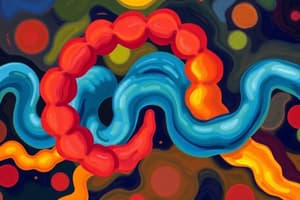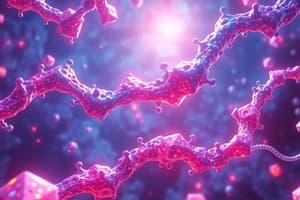Podcast
Questions and Answers
What is the primary reason organisms store glucose as glycogen?
What is the primary reason organisms store glucose as glycogen?
- To prepare glucose for gluconeogenesis.
- To enhance osmoregulation in the cell.
- To provide cells with quick access to large amounts of glucose. (correct)
- To increase blood glucose levels quickly.
What is the first step in the process of glycogenesis?
What is the first step in the process of glycogenesis?
- Activation of G6P to glycogen.
- Phosphorylation of glucose to glucose 6-phosphate. (correct)
- Elongation of glycogen polymers.
- Formation of UDP-glucose.
Which enzyme is responsible for converting glucose to glucose 6-phosphate during glycogenesis?
Which enzyme is responsible for converting glucose to glucose 6-phosphate during glycogenesis?
- Glycogen synthase.
- Amylase.
- Hexokinase. (correct)
- Phosphorylase.
What molecule must glucose 6-phosphate be activated to in order to participate in glycogenesis?
What molecule must glucose 6-phosphate be activated to in order to participate in glycogenesis?
Which of the following conditions stimulates the process of glycogenolysis?
Which of the following conditions stimulates the process of glycogenolysis?
During which metabolic process is glycogen synthesized?
During which metabolic process is glycogen synthesized?
What is the role of UDP-glucose in glycogenesis?
What is the role of UDP-glucose in glycogenesis?
What happens to glucose 6-phosphate after it is produced in glycogenesis?
What happens to glucose 6-phosphate after it is produced in glycogenesis?
What is the primary role of phosphoglucomutase in glycogen synthesis?
What is the primary role of phosphoglucomutase in glycogen synthesis?
What must happen to glucose 6-phosphate to activate it for glycogen synthesis?
What must happen to glucose 6-phosphate to activate it for glycogen synthesis?
What type of bond does the activated glucose form with the glycogen molecule?
What type of bond does the activated glucose form with the glycogen molecule?
Under what conditions is the conversion of glucose 6-phosphate to glucose 1-phosphate considered reversible?
Under what conditions is the conversion of glucose 6-phosphate to glucose 1-phosphate considered reversible?
What group must be transferred onto the phosphate during glucose activation?
What group must be transferred onto the phosphate during glucose activation?
Which carbon of glucose 6-phosphate is phosphorylated to facilitate glycogen synthesis?
Which carbon of glucose 6-phosphate is phosphorylated to facilitate glycogen synthesis?
What type of carbon does the activated glucose utilize in glycogen synthesis?
What type of carbon does the activated glucose utilize in glycogen synthesis?
During the process of glycogen synthesis, what initiates the formation of a glycosidic bond?
During the process of glycogen synthesis, what initiates the formation of a glycosidic bond?
What is the effect of transferring a phosphate group from carbon 6 to carbon 1 in glucose 6-phosphate?
What is the effect of transferring a phosphate group from carbon 6 to carbon 1 in glucose 6-phosphate?
What is the significance of the reducing end in glucose during glycogen synthesis?
What is the significance of the reducing end in glucose during glycogen synthesis?
What drives the activation of glucose 6-phosphate in the context of glycogen synthesis?
What drives the activation of glucose 6-phosphate in the context of glycogen synthesis?
Which step in glycogen synthesis occurs after glucose 6-phosphate is activated?
Which step in glycogen synthesis occurs after glucose 6-phosphate is activated?
What is the primary function of the anomeric carbon in activated glucose during glycogen synthesis?
What is the primary function of the anomeric carbon in activated glucose during glycogen synthesis?
How does the action of phosphoglucomutase affect glucose metabolism?
How does the action of phosphoglucomutase affect glucose metabolism?
Flashcards
Anabolic conditions
Anabolic conditions
A state of energy abundance, often triggered by the hormone insulin.
Catabolic conditions
Catabolic conditions
A state of energy depletion, often triggered by the hormone glucagon.
Glycogenesis
Glycogenesis
The process of synthesizing glycogen from glucose monomers, forming a highly branched polymer.
Glycogenolysis
Glycogenolysis
Signup and view all the flashcards
Hexokinase
Hexokinase
Signup and view all the flashcards
UDP-glucose
UDP-glucose
Signup and view all the flashcards
Glycogen
Glycogen
Signup and view all the flashcards
Glycogen storage
Glycogen storage
Signup and view all the flashcards
What is glucose 6-phosphate?
What is glucose 6-phosphate?
Signup and view all the flashcards
How is glucose 6-phosphate activated for glycogen synthesis?
How is glucose 6-phosphate activated for glycogen synthesis?
Signup and view all the flashcards
What enzyme moves the phosphate group?
What enzyme moves the phosphate group?
Signup and view all the flashcards
Is the conversion of glucose 6-phosphate to glucose 1-phosphate reversible?
Is the conversion of glucose 6-phosphate to glucose 1-phosphate reversible?
Signup and view all the flashcards
What is the specific reaction catalyzed by phosphoglucomutase?
What is the specific reaction catalyzed by phosphoglucomutase?
Signup and view all the flashcards
Which form of glucose is used by glycogen synthase?
Which form of glucose is used by glycogen synthase?
Signup and view all the flashcards
What is glycogen?
What is glycogen?
Signup and view all the flashcards
What is the anomeric carbon?
What is the anomeric carbon?
Signup and view all the flashcards
Why is the anomeric carbon of glucose 1-phosphate activated?
Why is the anomeric carbon of glucose 1-phosphate activated?
Signup and view all the flashcards
What is the reducing end?
What is the reducing end?
Signup and view all the flashcards
What is the nonreducing end?
What is the nonreducing end?
Signup and view all the flashcards
What is a glycosidic bond?
What is a glycosidic bond?
Signup and view all the flashcards
How does glycogen synthase build glycogen?
How does glycogen synthase build glycogen?
Signup and view all the flashcards
What is the overall significance of phosphoglucomutase and glycogen synthase?
What is the overall significance of phosphoglucomutase and glycogen synthase?
Signup and view all the flashcards
Study Notes
Glycogen Metabolism Introduction
- Glucose is the primary fuel source for cells, acquired from the diet.
- Organisms need to maintain a glucose supply between meals.
- Gluconeogenesis produces glucose but may not be fast enough in certain situations.
- Glycogen is a storage form of glucose, allowing quick access without disrupting osmotic balance.
Glycogenesis
- Glycogenesis involves the synthesis and elongation of glycogen molecules.
- Glucose is first phosphorylated to glucose-6-phosphate (G6P).
- G6P is converted to glucose-1-phosphate through phosphoglucomutase.
- UDP-glucose is formed from glucose-1-phosphate and UTP.
- Glycogen synthase adds UDP-glucose to an existing glycogen chain.
- A-1,4-glycosidic bonds are formed.
Glycogen Elongation
- Glycogen synthase catalyzes the transfer of glucose from UDP-glucose to the non-reducing end of a growing glycogen chain.
- This forms a new a-1,4-glycosidic bond resulting in the release of UDP.
Glycogen Priming
- Glycogen synthase can only elongate pre-existing glycogen chains.
- Glycogenin, a protein, acts as a core for the initial glucose addition.
- Glycogenin catalyzes the addition of the first few glucose units (using UDP-glucose) to its own tyrosine residues
- These initial units act as a primer for glycogen synthase to continue elongation.
Glycogen Branching
- Glycogen is highly branched.
- Glycogen branching enzyme transfers an oligosaccharide from the non-reducing end of a linear chain to carbon 6 of a more internal glucose unit.
- This creates a branch point (a-1,6 linkage) increasing the number of nonreducing ends.
Glycogenolysis
- Glycogenolysis breaks down glycogen into glucose subunits.
- Phosphorolysis (rather than hydrolysis) is primarily used (splitting with phosphate).
- Glycogen phosphorylase removes glucose-1-phosphate from the non-reducing end of a glycogen chain.
- a-1,4-glycosidic bonds are broken.
Debranching of Glycogen
- Debranching enzyme is required because glycogen phosphorylase cannot cleave alpha-1,6-glycosidic linkages.
- Debranching enzyme transfers a trisaccharide from a branch to the main chain.
- a-1,6-glucosidase hydrolyzes the remaining branch-point glucose residue to release a free glucose molecule.
Regulation of Glycogen Metabolism
- Glycogen phosphorylase, the key regulatory enzyme in glycogenolysis, is regulated by hormonal and allosteric mechanisms.
- Glucagon and epinephrine promote glycogenolysis (through hormonal pathways leading to PKA activation followed by phosphorylase kinase activation leading to further activation of phosphorylase)
- Insulin promotes glycogenesis.
- Allosteric effectors like AMP and calcium and Ca2+ are tissue specific and regulate glycogenolysis.
Studying That Suits You
Use AI to generate personalized quizzes and flashcards to suit your learning preferences.



